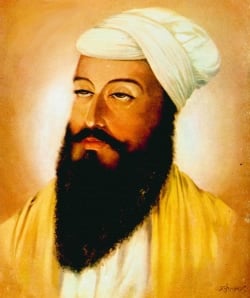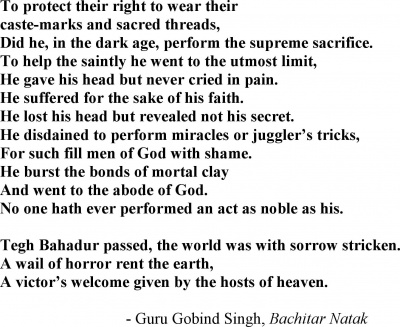Guru Tegh Bahadur
| Guru Tegh Bahadur (1621 to 1675) | |
| Full Name : | Tegh Mall |
| Personal Details | |
| Birth : | April 1, 1621 |
| Guruship : | 20 March 1665 |
| Joti Jot : | November 11, 1675 at Chandani Chownk New Delhi |
| Family | |
| Parents : | Guru Har Gobind & Mata Nanaki |
| Brother/Sisters : | Brother - Baba Gurditta, Baba Suraj Mal, Baba Ani Rai, Baba Atal Rai Sister - Bibi Biro |
| Spouse : | Mata Gujri |
| Children : | Guru Gobind Singh |
| Other Details | |
| Bani in GGS: | {{{Bani in GGS}}} |
| Other Info: | 115 hymns |
Guru Teg Bahadur Ji (April 1, 1621 - November 11, 1675) was the ninth of the Ten Gurus of Sikhism and became Guru on March 20, 1665 following in the footsteps of his grand-nephew, Guru Har Krishan Ji. Before Guruji left his body, he nominated his son, Gobind Rai – who later was renamed - Guru Gobind Singh Ji, as the next and as he turned out the last Guru of the Sikhs – in human form. The following is a summary of the main highlights of Guruji's life:
- built the city of Anandpur Sahib
- toured various parts of India
- responsible for saving the Kashmiri Hindus who were being persecuted by the Mughals, but had to lay down his own life.
- contributed 115 hymns to the Sri Guru Granth Sahib, all of them Sloks.
- The Saloks (Mahal 9) near the end of the Guru Granth Sahib are extremely popular.
- Guruji Martyred in Delhi by Mughal Emperor, Aurangzeb.
- Gurdwara Sis Ganj, Chandani Chowk, Delhi, where he was beheaded and Gurdwara Rakab Ganj Sahib, Delhi, where at the residence of Lakhi Shah Vanjara - who burnt his house so as to cremate Guruji’s body.
Brief Account
Guru Ji whose original name was Tyal Mal (Master of Detachment) spent his childhood at Amritsar. In his early years he learnt Gurmukhi, Hindi, Sanskrit and Indian religious philosophy from Bhai Gurdas, and archery and horsemanship from Baba Budha while his father Guru Hargobind Ji, Master of Miri and Piri taught him swordsmanship. At the age of 13, a brave young warrior fought alongside his father in the Battle of Kartarpur. When the victorious Sikhs returned home they praised their latest hero and Tyal Mal Ji was renamed Tegh Bahadur Ji (True Master of the Sword). He was married to Mata Gujri Ji at Kartarpur in 1632. When his father nominated his grandson Har Rai Ji as his successor in 1644, Tegh Bahadur Ji moved with his wife to the village of Bakala.
For the next 20 years the Master of Detachment spent most of his time in an underground room absorbed in meditation. Guru Ji also went on missionary tours in Uttar Pradesh, Bihar and Bengal. Before Guru Har Krishan Ji passed to God’s court, he indicated that his successor would be found in Bakala. When the Sikhs arrived in the village they found 22 false Gurus claiming to be Baba Bakala. A wealthy Sikh called Makhan Shah came to Bakala. He bowed to each Guru and gave 2 gold pieces; each Guru was pleased and blessed him. But Makhan Shah was unhappy, then he learnt of a holy man meditating in an underground room. Again Makhan Shah bowed and placed 2 gold pieces. Guru Tegh Bahadur Ji said: “Why have you broken your promise? When you prayed to God to save you and your ship from the terrible storm you promised 500 gold pieces to the Guru”. Makhan Shah was overjoyed, he gave the rest of the gold as promised and ran to the roof shouting “The True Guru has been found, O Sikhs come seek his blessing”. The false Gurus all ran away.
After a short time oppression and intolerance reared it’s ugly head. The Mughal Emperor Aurangzeb ordered Hindu temples to be destroyed and that idol worship was to be stopped. He had a temple converted into a Mosque and slaughtered a cow inside it. He also had Hindus sacked from their government jobs and employed Muslims instead. Aurangzeb also ordered Gurdwaras to be destroyed and expelled many missionaries from the main cities. Despite some resistance after many years of persecution people were being forced to take up Islam.
Aurangzeb being clever, decided if he could convert the leaders of the Hindu religion then millions of followers would also convert. He started persecuting and harassing the Hindu Pandits of Kashmir. The Pandits overcome by panic came in a delegation to Anandpur Sahib and requested Guru Tegh Bahadur Ji’s help. At this time Guru Ji’s 9 year old son Gobind Rai Ji told his father that “Who would be better than you to defend the poor Brahmins”. Guru Tegh Bahadur Ji decided to stand up for the right of freedom of worship and told the delegation he was ready to sacrifice his life to protect the Hindus from mass conversion.
Guru Ji nominated Gobind Rai as his successor and left for Delhi with 3 other Sikhs, Bhai Sati Das, Bhai Mati Das and Bhai Dayal Das. Along the way all were arrested and taken to Delhi were all accepted death by torture rather than give up their ideals and convert to Islam. Guru Ji was beheaded on 11 November 1675, Bhai Jetha took Guru Ji’s head to Anandpur Sahib were it was cremated and Bhai Lakhi Shah carried Guru Ji’s body to his house, which he then set on fire to cremate Guru Ji’s body.
Guru Tegh Bahadur Ji had a versatile personality, a warrior, family man with social commitment and a preacher of great understanding and vision. His martyrdom broke the myth of Aurangzeb’s religiosty.
The achievements of Guru Tegh Bahadur are remarkable;
- During the last period in Guru Ji’s life, Guru Ji founded a new town called Anandpur Sahib (City of Bliss) and went on missionary tours to UP and Bengal. Guru Ji also initated welfare projects all over northern Panjab.
- Guru Ji symbolised the triumph of good over evil, Guru Ji’s martyrdom unique in the history of mankind, inspired many Sikhs to lay down their lives for noble causes and moral values.
- Guru Ji was also a versatile poet and embodied a message of freedom, courage and compassion; “Fear not and frighten not “.
Timeline
| # | YEAR | EVENT | AGE |
|---|---|---|---|
| 1 | 1621 | Born at Amritsar | |
| 2 | 1632 | Marriage with Mata Gujri | 11 |
| 3 | 1665 | Anointed as the Ninth Guru | 44 |
| 4 | 1666 | Birth of Guru Gobind Singh ji | 45 |
| 5 | 1666 | Founded city of Anandpur | 45 |
| 6 | 1666-70 | Visited Bengal and Assam | 45-49 |
| 7 | 1670 | Return to Punjab | 49 |
| 8 | 1673 | Second tour of Malwa | 52 |
| 9 | 1675 | Petition of Kashmiri Pandits | 54 |
| 10 | 1675 | Martyrdom due to the above Petition | 54 |
Also See
External links
- Eternal Glory of Sri Guru Tegh Bahadur Sahib
- Sikh Missionary Society
- Video on the Martyrdom of Sri Guru Teg Bahadur Sahib
eBooks:
| Preceded by: Guru Har Krishan (7 July 1656 - 30 March 1664) |
Guru Teg Bahadur | Followed by: Guru Gobind Singh (22 December 1666 - 7 October 1708) |
| These are the Ten Gurus of Sikhism |
|
Guru Nanak | Guru Angad Dev | Guru Amar Das | Guru Ram Das | Guru Arjan | Guru Hargobind | Guru Har Rai | Guru Har Krishan | Guru Teg Bahadur | Guru Gobind Singh |


